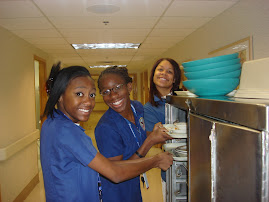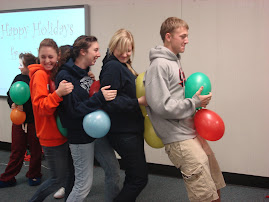Sunday, September 27, 2009
Instructional Design
How are the two models of instructional design similar to one another?
The two models are similar to each other in several ways. Both gain attention of the learner. Gagne presents a stimulus and Keller presents relevance, both may encourage interest in the subject being taught, and show how the student might use the knowledge.
How do the two models of instructional design differ from one another?
The two models differ both in the way they are presented to educators, and in the way in which they model the effectiveness of their design. Gagne elicits performance, provides feedback and then assesses performance, while Keller is using strategies of confidence and satisfaction. It is much more rewarding to see a student ‘finally get it, or watch the proverbial light bulb go on’ when they put their learning into practice and see the relevance of what has been taught, then it is to have your words given back to you because they have memorized text or notes from a lecture.
Define the process for starting the design phase for a specific lesson you can use in your own curriculum. You should describe your potential audience (general characteristics, prior knowledge, demographics, and motivations). List any societal factors that may affect your lesson as well.
I will dabble in the ARCS for my lesson, as I am very tired of the 9 commandments, but did get a laugh out of the way they were presented on the blog. I related to each of those!
First, the lesson in my curriculum that I will apply this to is my lesson on Asepsis. This lesson is fairly simple and combines science with common sense. (Okay, everyone knows they should wash their hands to get rid of germs, but do they know that 98% of the time, they miss significant parts of their hands, or what bugs can crawl into a callous or torn cuticle?) My audience, 12th graders interested in a career in medicine. Demographics range from the side of the city with the country club, to the side across the tracks. Not all of my students are fluent enough in English to understand some of he medical terminology, and many do not own computers, or only have access at school.
My design phase will begin with getting the students attention using pictures of persons infected with bacteria that has gotten through the barrier of skin, and diseases that were transferred from the hands of a healthcare worker to their patient. I may be crossing over into relevance at this point, I am sure in this lesson we will cross between the motivation and appeal multiple times.
I really appreciated Richardson’s views on how school districts often have such a long list of don’ts regarding computer use that it makes difficult to find and utilize the unending resources available to teachers and students. I had to request that the Arizona Board of Nursing website be unblocked for my use, and justify why I needed it unblocked for students. It is a government sight.
Teaching healthcare, I require the students to research diseases, most of which you have to find a path around the blocks in order to find what you need. (IE cancer of the breast instead of breast cancer….breast is on the blocked list.)
A list of do’s rather than don’t would be such a positive way to greet our students, and set the feeling tone for the year ahead. ‘Do use our network to connect to other students who share your passions with whom you can learn. Do use our network to explore your passions, to ask questions and seek answers. Do use our network to collaborate with others in meaningful, positive ways.’ I will try a new approach.
Regarding the Obama speech, I would again have to agree. I think we really did our students disservices by not allowing them to watch or listen to our President speak. I may not agree with the man, and may not have voted for him, but he is still the man that we put into office. How can we teach our students respect if we vote him in and then block his speeches because we fear that he is manipulating and brainwashing our children? Really?
We missed an opportunity to teach our students that the person we put into office deserves respect, whether we agree or not. We missed an opportunity to allow debate between our students-the opportunity to teach them to think for themselves, and that they have the freedom to do that and express their thoughts. The election of Obama was a historic moment, and we block this from our history classes.
Saturday, September 19, 2009
Teaching Philosophy...
I believe education is a process, which differs for every person and every student. Education has many important components and will take the commitment of teachers, parents, administrators, students, and paraprofessionals. I believe every person is entitled to an education and has the innate ability to learn. As an educator I have the responsibility to provide a classroom environment that gives every student the chance to capture knowledge and progress as an individual. I believe learning should be a fun activity that involves excitement on the teachers and on the student’s behalf. If the students are excited to share the knowledge they have learned, they will retain the knowledge acquired providing them with a concrete foundation to continue to build on. I believe that in order to create this foundation, a balanced teaching approach is necessary. This will include both teacher-centered curriculum, and student-centered learning.
My enthusiasm for teaching started as a teacher. I discovered a new passion utilizing my first career choice and have had incredible support from colleagues and administrators who are also passionate about teaching and life. Students are the reason I desire to teach. I will provide them with an environment in which they may actively pursue education and explore career choices through providing a plethora of materials and information to engage the students in pursing their education. As a nurse I believe that health and healthcare are a vital part of culture. I feel that students will become engaged when they begin to see the relevance of health and healthcare to their lives or the lives of family and friends.
In my classroom experience I have learned to teach a diverse group of students and manage a classroom while meeting the needs of each student. I believe that it is important to provide the students with a safe environment where cooperative learning may take place. These experiences have taught me the importance of maintaining an equitable environment in my classroom and clinical settings that will entice students and make learning enjoyable. I believe discipline needs to be appropriate and consistent in order to maintain an effective classroom environment.
I believe that educators play and essential role in the lives of their students and community. They have the ability to make all learning experiences positive for student’s using effective teaching and clear objectives/ standards. Education is one of the few professions that allow individuals to step into a new culture and learn with every unique group of students. I look forward to continue impacting students and communities for the better as I maintain my commitment to excellence.


